dashboard FIAT TALENTO 2021 Owner handbook (in English)
[x] Cancel search | Manufacturer: FIAT, Model Year: 2021, Model line: TALENTO, Model: FIAT TALENTO 2021Pages: 236, PDF Size: 4.86 MB
Page 32 of 236
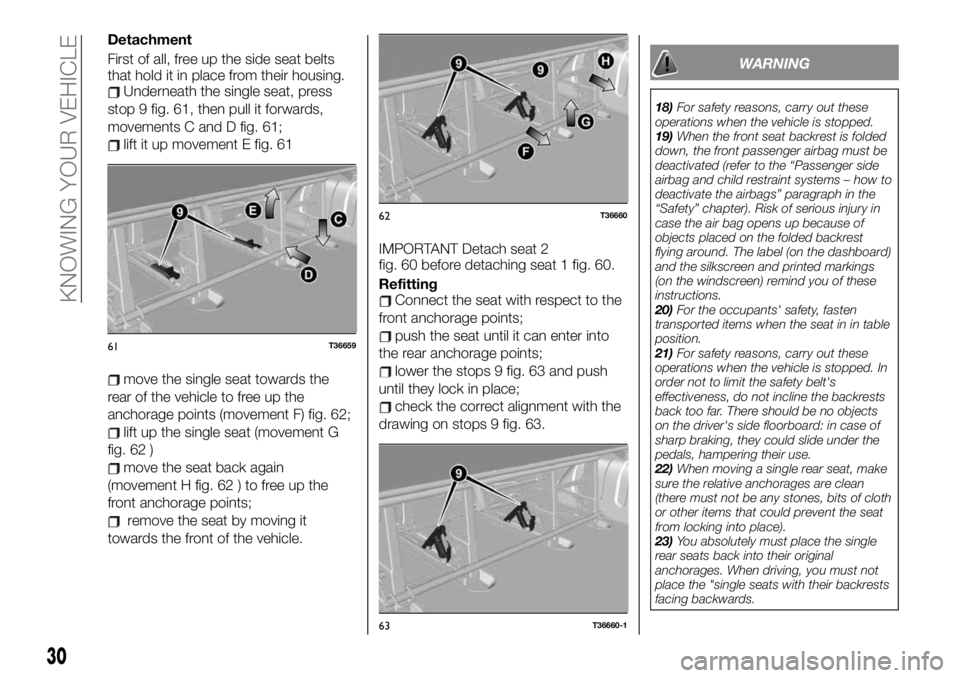
Detachment
First of all, free up the side seat belts
that hold it in place from their housing.
Underneath the single seat, press
stop 9 fig. 61, then pull it forwards,
movements C and D fig. 61;
lift it up movement E fig. 61
move the single seat towards the
rear of the vehicle to free up the
anchorage points (movement F) fig. 62;
lift up the single seat (movement G
fig. 62 )
move the seat back again
(movement H fig. 62 ) to free up the
front anchorage points;
remove the seat by moving it
towards the front of the vehicle.IMPORTANT Detach seat 2
fig. 60 before detaching seat 1 fig. 60.
Refitting
Connect the seat with respect to the
front anchorage points;
push the seat until it can enter into
the rear anchorage points;
lower the stops 9 fig. 63 and push
until they lock in place;
check the correct alignment with the
drawing on stops 9 fig. 63.
WARNING
18)For safety reasons, carry out these
operations when the vehicle is stopped.
19)When the front seat backrest is folded
down, the front passenger airbag must be
deactivated (refer to the “Passenger side
airbag and child restraint systems – how to
deactivate the airbags” paragraph in the
“Safety” chapter). Risk of serious injury in
case the air bag opens up because of
objects placed on the folded backrest
flying around. The label (on the dashboard)
and the silkscreen and printed markings
(on the windscreen) remind you of these
instructions.
20)For the occupants' safety, fasten
transported items when the seat in in table
position.
21)For safety reasons, carry out these
operations when the vehicle is stopped. In
order not to limit the safety belt's
effectiveness, do not incline the backrests
back too far. There should be no objects
on the driver's side floorboard: in case of
sharp braking, they could slide under the
pedals, hampering their use.
22)When moving a single rear seat, make
sure the relative anchorages are clean
(there must not be any stones, bits of cloth
or other items that could prevent the seat
from locking into place).
23)You absolutely must place the single
rear seats back into their original
anchorages. When driving, you must not
place the "single seats with their backrests
facing backwards.
61T36659
62T36660
63T36660-1
30
KNOWING YOUR VEHICLE
Page 52 of 236
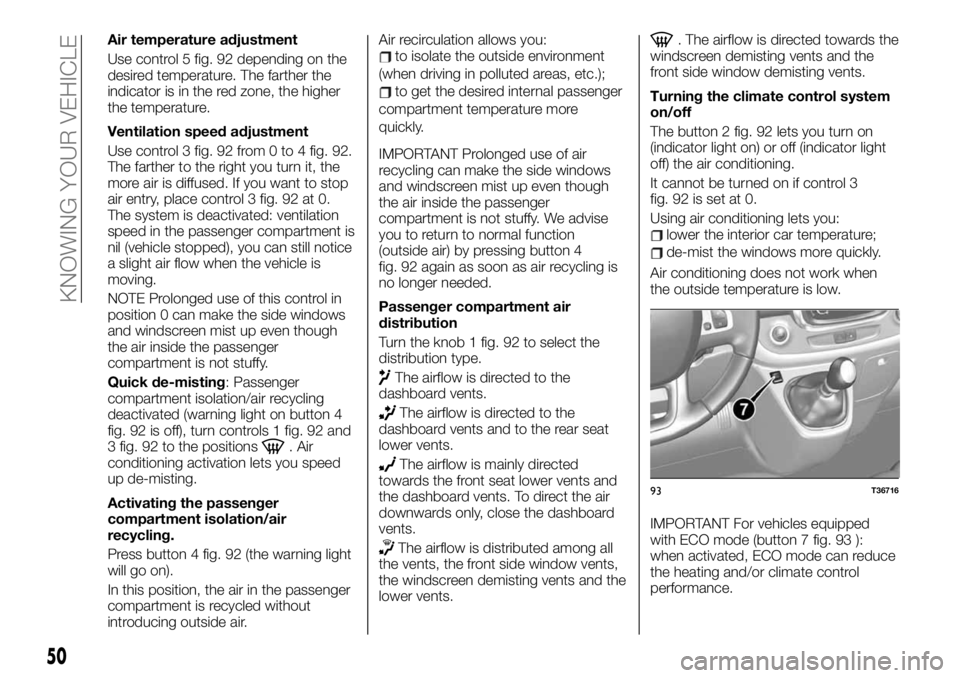
Air temperature adjustment
Use control 5 fig. 92 depending on the
desired temperature. The farther the
indicator is in the red zone, the higher
the temperature.
Ventilation speed adjustment
Use control 3 fig. 92 from 0 to 4 fig. 92.
The farther to the right you turn it, the
more air is diffused. If you want to stop
air entry, place control 3 fig. 92 at 0.
The system is deactivated: ventilation
speed in the passenger compartment is
nil (vehicle stopped), you can still notice
a slight air flow when the vehicle is
moving.
NOTE Prolonged use of this control in
position 0 can make the side windows
and windscreen mist up even though
the air inside the passenger
compartment is not stuffy.
Quick de-misting: Passenger
compartment isolation/air recycling
deactivated (warning light on button 4
fig. 92 is off), turn controls 1 fig. 92 and
3 fig. 92 to the positions
. Air
conditioning activation lets you speed
up de-misting.
Activating the passenger
compartment isolation/air
recycling.
Press button 4 fig. 92 (the warning light
will go on).
In this position, the air in the passenger
compartment is recycled without
introducing outside air.Air recirculation allows you:
to isolate the outside environment
(when driving in polluted areas, etc.);
to get the desired internal passenger
compartment temperature more
quickly.
IMPORTANT Prolonged use of air
recycling can make the side windows
and windscreen mist up even though
the air inside the passenger
compartment is not stuffy. We advise
you to return to normal function
(outside air) by pressing button 4
fig. 92 again as soon as air recycling is
no longer needed.
Passenger compartment air
distribution
Turn the knob 1 fig. 92 to select the
distribution type.
The airflow is directed to the
dashboard vents.
The airflow is directed to the
dashboard vents and to the rear seat
lower vents.
The airflow is mainly directed
towards the front seat lower vents and
the dashboard vents. To direct the air
downwards only, close the dashboard
vents.
The airflow is distributed among all
the vents, the front side window vents,
the windscreen demisting vents and the
lower vents.
. The airflow is directed towards the
windscreen demisting vents and the
front side window demisting vents.
Turning the climate control system
on/off
The button 2 fig. 92 lets you turn on
(indicator light on) or off (indicator light
off) the air conditioning.
It cannot be turned on if control 3
fig. 92 is set at 0.
Using air conditioning lets you:
lower the interior car temperature;
de-mist the windows more quickly.
Air conditioning does not work when
the outside temperature is low.
IMPORTANT For vehicles equipped
with ECO mode (button 7 fig. 93 ):
when activated, ECO mode can reduce
the heating and/or climate control
performance.
93T36716
50
KNOWING YOUR VEHICLE
Page 55 of 236
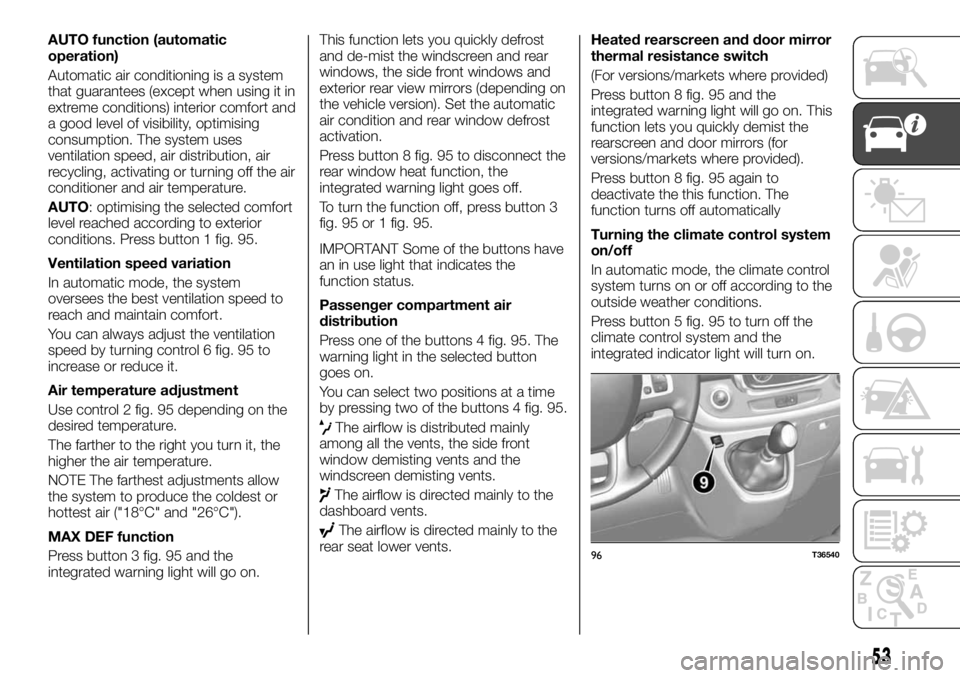
AUTO function (automatic
operation)
Automatic air conditioning is a system
that guarantees (except when using it in
extreme conditions) interior comfort and
a good level of visibility, optimising
consumption. The system uses
ventilation speed, air distribution, air
recycling, activating or turning off the air
conditioner and air temperature.
AUTO: optimising the selected comfort
level reached according to exterior
conditions. Press button 1 fig. 95.
Ventilation speed variation
In automatic mode, the system
oversees the best ventilation speed to
reach and maintain comfort.
You can always adjust the ventilation
speed by turning control 6 fig. 95 to
increase or reduce it.
Air temperature adjustment
Use control 2 fig. 95 depending on the
desired temperature.
The farther to the right you turn it, the
higher the air temperature.
NOTE The farthest adjustments allow
the system to produce the coldest or
hottest air ("18°C" and "26°C").
MAX DEF function
Press button 3 fig. 95 and the
integrated warning light will go on.This function lets you quickly defrost
and de-mist the windscreen and rear
windows, the side front windows and
exterior rear view mirrors (depending on
the vehicle version). Set the automatic
air condition and rear window defrost
activation.
Press button 8 fig. 95 to disconnect the
rear window heat function, the
integrated warning light goes off.
To turn the function off, press button 3
fig. 95 or 1 fig. 95.
IMPORTANT Some of the buttons have
an in use light that indicates the
function status.
Passenger compartment air
distribution
Press one of the buttons 4 fig. 95. The
warning light in the selected button
goes on.
You can select two positions at a time
by pressing two of the buttons 4 fig. 95.
The airflow is distributed mainly
among all the vents, the side front
window demisting vents and the
windscreen demisting vents.
The airflow is directed mainly to the
dashboard vents.
The airflow is directed mainly to the
rear seat lower vents.Heated rearscreen and door mirror
thermal resistance switch
(For versions/markets where provided)
Press button 8 fig. 95 and the
integrated warning light will go on. This
function lets you quickly demist the
rearscreen and door mirrors (for
versions/markets where provided).
Press button 8 fig. 95 again to
deactivate the this function. The
function turns off automatically
Turning the climate control system
on/off
In automatic mode, the climate control
system turns on or off according to the
outside weather conditions.
Press button 5 fig. 95 to turn off the
climate control system and the
integrated indicator light will turn on.
96T36540
53
Page 65 of 236
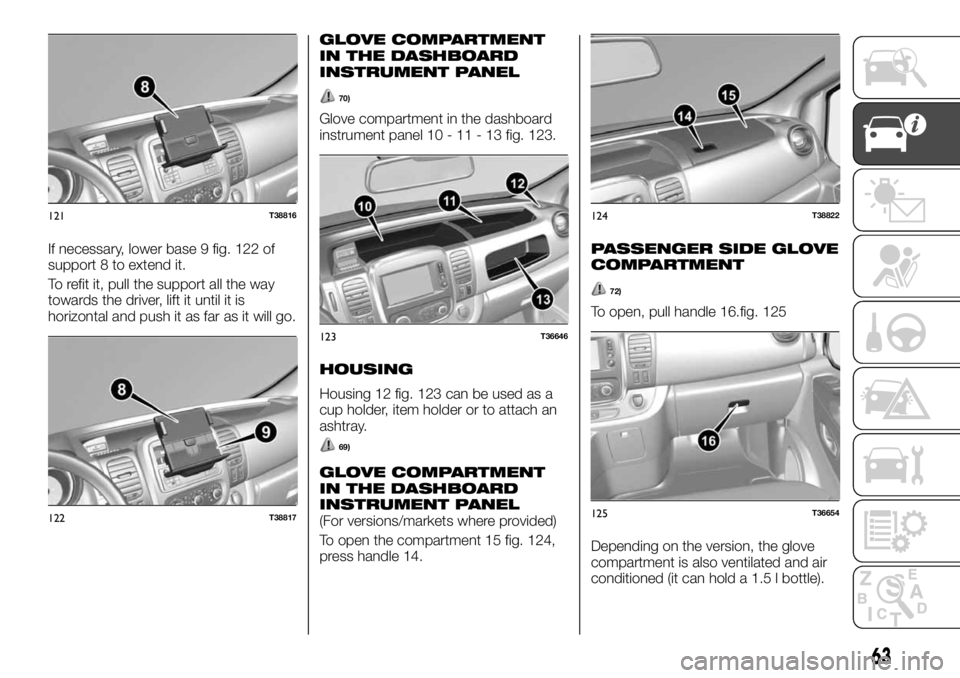
If necessary, lower base 9 fig. 122 of
support 8 to extend it.
To refit it, pull the support all the way
towards the driver, lift it until it is
horizontal and push it as far as it will go.
GLOVE COMPARTMENT
IN THE DASHBOARD
INSTRUMENT PANEL
70)
Glove compartment in the dashboard
instrument panel 10 - 11 - 13 fig. 123.
HOUSING
Housing 12 fig. 123 can be used as a
cup holder, item holder or to attach an
ashtray.
69)
GLOVE COMPARTMENT
IN THE DASHBOARD
INSTRUMENT PANEL
(For versions/markets where provided)
To open the compartment 15 fig. 124,
press handle 14.
PASSENGER SIDE GLOVE
COMPARTMENT
72)
To open, pull handle 16.fig. 125
Depending on the version, the glove
compartment is also ventilated and air
conditioned (it can hold a 1.5 l bottle).
121T38816
122T38817
123T36646
124T38822
125T36654
63
Page 98 of 236
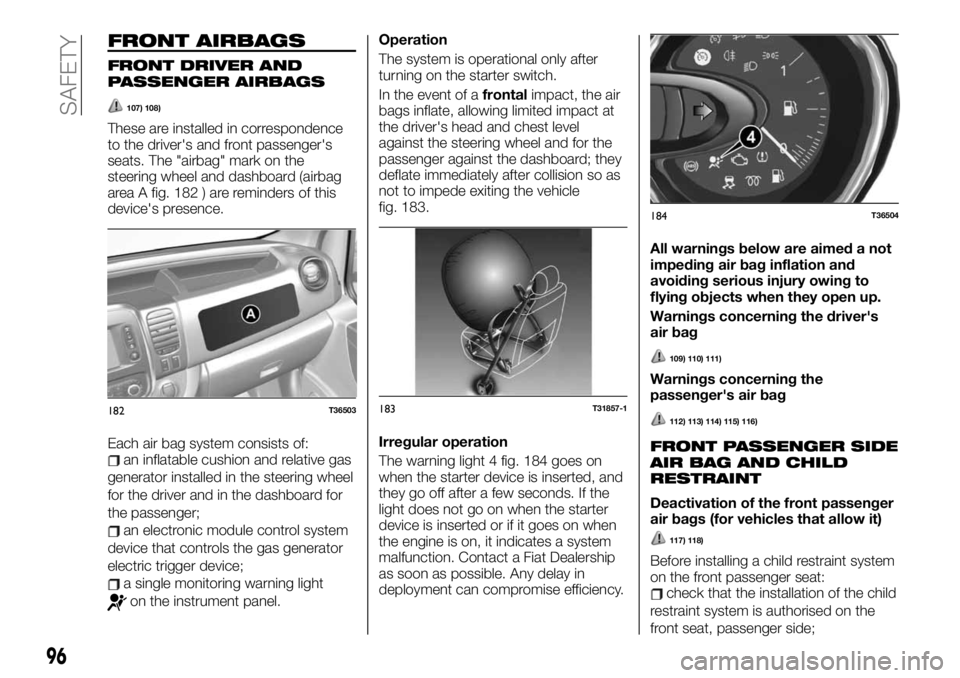
FRONT AIRBAGS
FRONT DRIVER AND
PASSENGER AIRBAGS
107) 108)
These are installed in correspondence
to the driver's and front passenger's
seats. The "airbag" mark on the
steering wheel and dashboard (airbag
area A fig. 182 ) are reminders of this
device's presence.
Each air bag system consists of:
an inflatable cushion and relative gas
generator installed in the steering wheel
for the driver and in the dashboard for
the passenger;
an electronic module control system
device that controls the gas generator
electric trigger device;
a single monitoring warning light
on the instrument panel.Operation
The system is operational only after
turning on the starter switch.
In the event of afrontalimpact, the air
bags inflate, allowing limited impact at
the driver's head and chest level
against the steering wheel and for the
passenger against the dashboard; they
deflate immediately after collision so as
not to impede exiting the vehicle
fig. 183.
Irregular operation
The warning light 4 fig. 184 goes on
when the starter device is inserted, and
they go off after a few seconds. If the
light does not go on when the starter
device is inserted or if it goes on when
the engine is on, it indicates a system
malfunction. Contact a Fiat Dealership
as soon as possible. Any delay in
deployment can compromise efficiency.All warnings below are aimed a not
impeding air bag inflation and
avoiding serious injury owing to
flying objects when they open up.
Warnings concerning the driver's
air bag
109) 110) 111)
Warnings concerning the
passenger's air bag
112) 113) 114) 115) 116)
FRONT PASSENGER SIDE
AIR BAG AND CHILD
RESTRAINT
Deactivation of the front passenger
air bags (for vehicles that allow it)
117) 118)
Before installing a child restraint system
on the front passenger seat:
check that the installation of the child
restraint system is authorised on the
front seat, passenger side;
182T36503183T31857-1
184T36504
96
SAFETY
Page 99 of 236
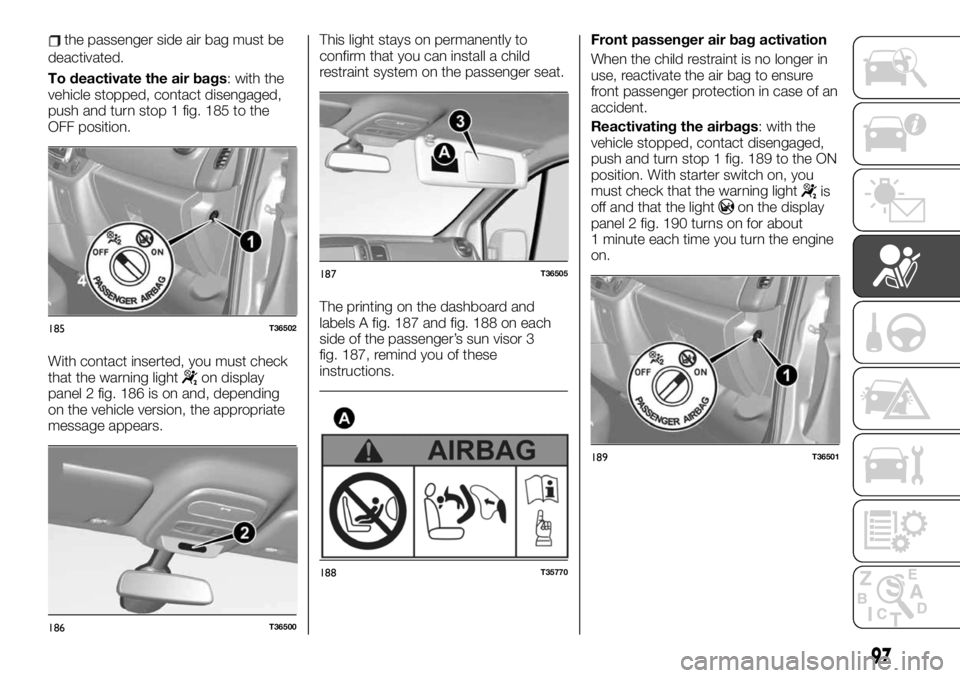
the passenger side air bag must be
deactivated.
To deactivate the air bags: with the
vehicle stopped, contact disengaged,
push and turn stop 1 fig. 185 to the
OFF position.
With contact inserted, you must check
that the warning light
on display
panel 2 fig. 186 is on and, depending
on the vehicle version, the appropriate
message appears.This light stays on permanently to
confirm that you can install a child
restraint system on the passenger seat.
The printing on the dashboard and
labels A fig. 187 and fig. 188 on each
side of the passenger’s sun visor 3
fig. 187, remind you of these
instructions.Front passenger air bag activation
When the child restraint is no longer in
use, reactivate the air bag to ensure
front passenger protection in case of an
accident.
Reactivating the airbags: with the
vehicle stopped, contact disengaged,
push and turn stop 1 fig. 189 to the ON
position. With starter switch on, you
must check that the warning light
is
off and that the lighton the display
panel 2 fig. 190 turns on for about
1 minute each time you turn the engine
on.
185T36502
186T36500
187T36505
188T35770
189T36501
97
Page 100 of 236
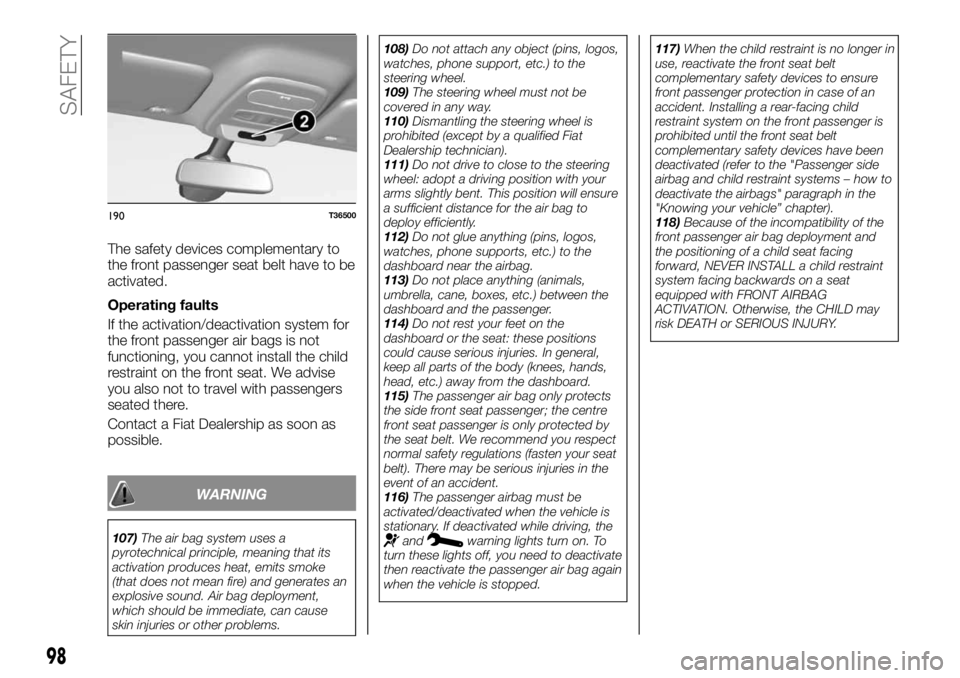
The safety devices complementary to
the front passenger seat belt have to be
activated.
Operating faults
If the activation/deactivation system for
the front passenger air bags is not
functioning, you cannot install the child
restraint on the front seat. We advise
you also not to travel with passengers
seated there.
Contact a Fiat Dealership as soon as
possible.
WARNING
107)The air bag system uses a
pyrotechnical principle, meaning that its
activation produces heat, emits smoke
(that does not mean fire) and generates an
explosive sound. Air bag deployment,
which should be immediate, can cause
skin injuries or other problems.108)Do not attach any object (pins, logos,
watches, phone support, etc.) to the
steering wheel.
109)The steering wheel must not be
covered in any way.
110)Dismantling the steering wheel is
prohibited (except by a qualified Fiat
Dealership technician).
111)Do not drive to close to the steering
wheel: adopt a driving position with your
arms slightly bent. This position will ensure
a sufficient distance for the air bag to
deploy efficiently.
112)Do not glue anything (pins, logos,
watches, phone supports, etc.) to the
dashboard near the airbag.
113)Do not place anything (animals,
umbrella, cane, boxes, etc.) between the
dashboard and the passenger.
114)Do not rest your feet on the
dashboard or the seat: these positions
could cause serious injuries. In general,
keep all parts of the body (knees, hands,
head, etc.) away from the dashboard.
115)The passenger air bag only protects
the side front seat passenger; the centre
front seat passenger is only protected by
the seat belt. We recommend you respect
normal safety regulations (fasten your seat
belt). There may be serious injuries in the
event of an accident.
116)The passenger airbag must be
activated/deactivated when the vehicle is
stationary. If deactivated while driving, theandwarning lights turn on. To
turn these lights off, you need to deactivate
then reactivate the passenger air bag again
when the vehicle is stopped.117)When the child restraint is no longer in
use, reactivate the front seat belt
complementary safety devices to ensure
front passenger protection in case of an
accident. Installing a rear-facing child
restraint system on the front passenger is
prohibited until the front seat belt
complementary safety devices have been
deactivated (refer to the "Passenger side
airbag and child restraint systems – how to
deactivate the airbags" paragraph in the
"Knowing your vehicle” chapter).
118)Because of the incompatibility of the
front passenger air bag deployment and
the positioning of a child seat facing
forward, NEVER INSTALL a child restraint
system facing backwards on a seat
equipped with FRONT AIRBAG
ACTIVATION. Otherwise, the CHILD may
risk DEATH or SERIOUS INJURY.
190T36500
98
SAFETY
Page 103 of 236
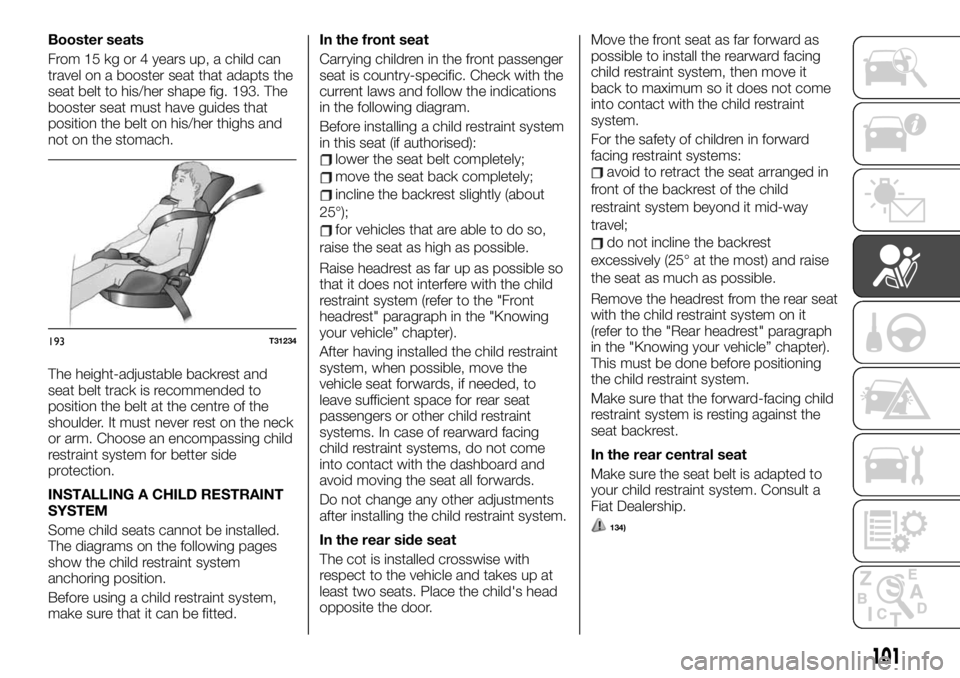
Booster seats
From 15 kg or 4 years up, a child can
travel on a booster seat that adapts the
seat belt to his/her shape fig. 193. The
booster seat must have guides that
position the belt on his/her thighs and
not on the stomach.
The height-adjustable backrest and
seat belt track is recommended to
position the belt at the centre of the
shoulder. It must never rest on the neck
or arm. Choose an encompassing child
restraint system for better side
protection.
INSTALLING A CHILD RESTRAINT
SYSTEM
Some child seats cannot be installed.
The diagrams on the following pages
show the child restraint system
anchoring position.
Before using a child restraint system,
make sure that it can be fitted.In the front seat
Carrying children in the front passenger
seat is country-specific. Check with the
current laws and follow the indications
in the following diagram.
Before installing a child restraint system
in this seat (if authorised):
lower the seat belt completely;
move the seat back completely;
incline the backrest slightly (about
25°);
for vehicles that are able to do so,
raise the seat as high as possible.
Raise headrest as far up as possible so
that it does not interfere with the child
restraint system (refer to the "Front
headrest" paragraph in the "Knowing
your vehicle” chapter).
After having installed the child restraint
system, when possible, move the
vehicle seat forwards, if needed, to
leave sufficient space for rear seat
passengers or other child restraint
systems. In case of rearward facing
child restraint systems, do not come
into contact with the dashboard and
avoid moving the seat all forwards.
Do not change any other adjustments
after installing the child restraint system.
In the rear side seat
The cot is installed crosswise with
respect to the vehicle and takes up at
least two seats. Place the child's head
opposite the door.Move the front seat as far forward as
possible to install the rearward facing
child restraint system, then move it
back to maximum so it does not come
into contact with the child restraint
system.
For the safety of children in forward
facing restraint systems:
avoid to retract the seat arranged in
front of the backrest of the child
restraint system beyond it mid-way
travel;
do not incline the backrest
excessively (25° at the most) and raise
the seat as much as possible.
Remove the headrest from the rear seat
with the child restraint system on it
(refer to the "Rear headrest" paragraph
in the "Knowing your vehicle” chapter).
This must be done before positioning
the child restraint system.
Make sure that the forward-facing child
restraint system is resting against the
seat backrest.
In the rear central seat
Make sure the seat belt is adapted to
your child restraint system. Consult a
Fiat Dealership.
134)
193T31234
101
Page 139 of 236
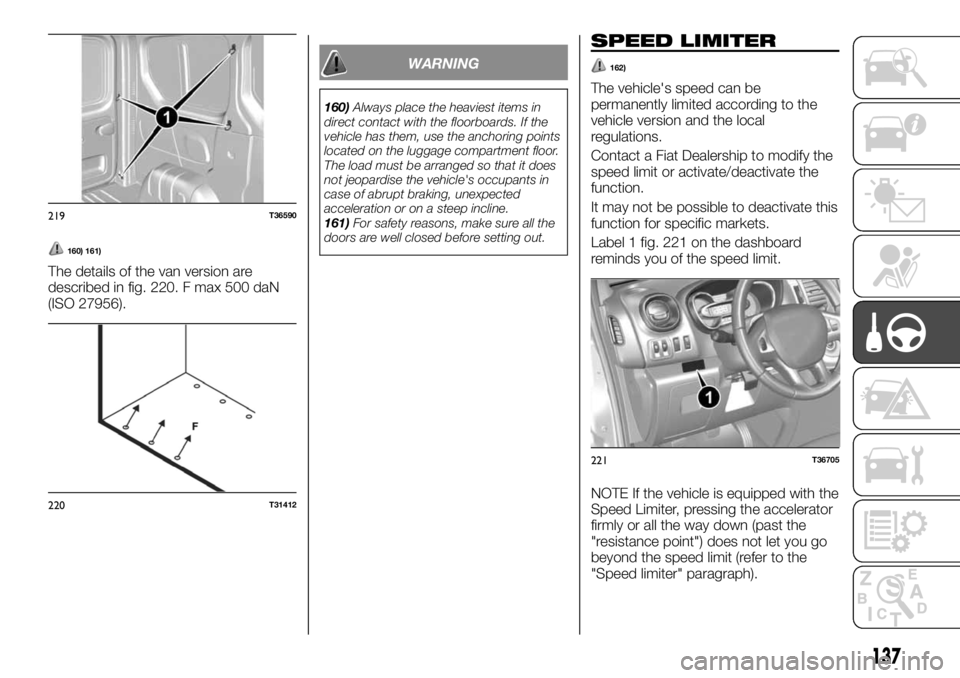
160) 161)
The details of the van version are
described in fig. 220. F max 500 daN
(ISO 27956).
WARNING
160)Always place the heaviest items in
direct contact with the floorboards. If the
vehicle has them, use the anchoring points
located on the luggage compartment floor.
The load must be arranged so that it does
not jeopardise the vehicle's occupants in
case of abrupt braking, unexpected
acceleration or on a steep incline.
161)For safety reasons, make sure all the
doors are well closed before setting out.
SPEED LIMITER
162)
The vehicle's speed can be
permanently limited according to the
vehicle version and the local
regulations.
Contact a Fiat Dealership to modify the
speed limit or activate/deactivate the
function.
It may not be possible to deactivate this
function for specific markets.
Label 1 fig. 221 on the dashboard
reminds you of the speed limit.
NOTE If the vehicle is equipped with the
Speed Limiter, pressing the accelerator
firmly or all the way down (past the
"resistance point") does not let you go
beyond the speed limit (refer to the
"Speed limiter" paragraph).
219T36590
220T31412
221T36705
137
Page 158 of 236
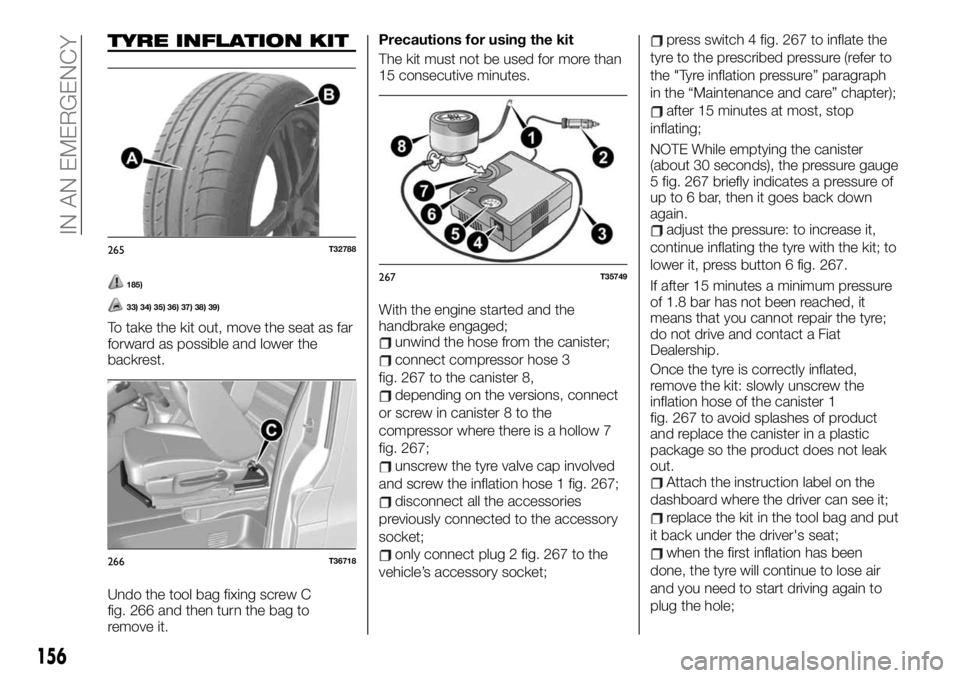
TYRE INFLATION KIT
185)
33) 34) 35) 36) 37) 38) 39)
To take the kit out, move the seat as far
forward as possible and lower the
backrest.
Undo the tool bag fixing screw C
fig. 266 and then turn the bag to
remove it.Precautions for using the kit
The kit must not be used for more than
15 consecutive minutes.
With the engine started and the
handbrake engaged;unwind the hose from the canister;
connect compressor hose 3
fig. 267 to the canister 8,
depending on the versions, connect
or screw in canister 8 to the
compressor where there is a hollow 7
fig. 267;
unscrew the tyre valve cap involved
and screw the inflation hose 1 fig. 267;
disconnect all the accessories
previously connected to the accessory
socket;
only connect plug 2 fig. 267 to the
vehicle’s accessory socket;
press switch 4 fig. 267 to inflate the
tyre to the prescribed pressure (refer to
the "Tyre inflation pressure” paragraph
in the “Maintenance and care” chapter);
after 15 minutes at most, stop
inflating;
NOTE While emptying the canister
(about 30 seconds), the pressure gauge
5 fig. 267 briefly indicates a pressure of
up to 6 bar, then it goes back down
again.
adjust the pressure: to increase it,
continue inflating the tyre with the kit; to
lower it, press button 6 fig. 267.
If after 15 minutes a minimum pressure
of 1.8 bar has not been reached, it
means that you cannot repair the tyre;
do not drive and contact a Fiat
Dealership.
Once the tyre is correctly inflated,
remove the kit: slowly unscrew the
inflation hose of the canister 1
fig. 267 to avoid splashes of product
and replace the canister in a plastic
package so the product does not leak
out.
Attach the instruction label on the
dashboard where the driver can see it;
replace the kit in the tool bag and put
it back under the driver's seat;
when the first inflation has been
done, the tyre will continue to lose air
and you need to start driving again to
plug the hole;
265T32788
266T36718
267T35749
156
IN AN EMERGENCY